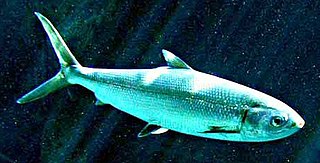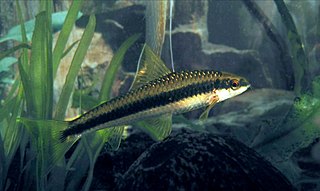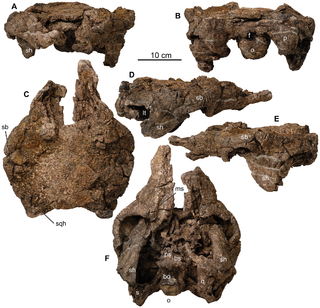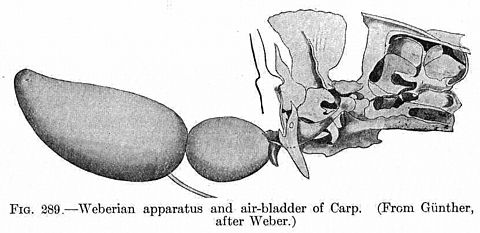
The swim bladder, gas bladder, fish maw, or air bladder is an internal gas-filled organ that contributes to the ability of many bony fish to control their buoyancy, and thus to stay at their current water depth without having to expend energy in swimming. Also, the dorsal position of the swim bladder means the center of mass is below the center of volume, allowing it to act as a stabilizing agent. Additionally, the swim bladder functions as a resonating chamber, to produce or receive sound.

Fish anatomy is the study of the form or morphology of fish. It can be contrasted with fish physiology, which is the study of how the component parts of fish function together in the living fish. In practice, fish anatomy and fish physiology complement each other, the former dealing with the structure of a fish, its organs or component parts and how they are put together, such as might be observed on the dissecting table or under the microscope, and the latter dealing with how those components function together in living fish.

The axial skeleton is the part of the skeleton that consists of the bones of the head and trunk of a vertebrate. In the human skeleton, it consists of 80 bones and is composed of six parts; the skull, also the ossicles of the middle ear, the hyoid bone, the rib cage, sternum and the vertebral column. The axial skeleton together with the appendicular skeleton form the complete skeleton. Another definition of axial skeleton is the bones including the vertebrae, sacrum, coccyx, skull, ribs, and sternum.

Ostariophysi is the second-largest superorder of fish. Members of this superorder are called ostariophysians. This diverse group contains 10,758 species, about 28% of known fish species in the world and 68% of freshwater species, and are present on all continents except Antarctica. They have a number of common characteristics such as an alarm substance and a Weberian apparatus. Members of this group include fish important to people for food, sport, the aquarium industry, and research.
Terminologia Anatomica is the international standard for human anatomical terminology. It is developed by the Federative International Programme on Anatomical Terminology, a program of the International Federation of Associations of Anatomists (IFAA). The second edition was released in 2019 and approved and adopted by the IFAA General Assembly in 2020. Terminologia Anatomica supersedes the previous standard, Nomina Anatomica. It contains terminology for about 7500 human anatomical structures.

Huabeisaurus was a genus of dinosaur from the Late Cretaceous. It was a sauropod which lived in what is present-day northern China. The type species, Huabeisaurus allocotus, was first described by Pang Qiqing and Cheng Zhengwu in 2000. Huabeisaurus is known from numerous remains found in the 1990s, which include teeth, partial limbs and vertebrae. Due to its relative completeness, Huabeisaurus represents a significant taxon for understanding sauropod evolution in Asia. Huabeisaurus comes from Kangdailiang and Houyu, Zhaojiagou Town, Tianzhen County, Shanxi province, China. The holotype was found in the unnamed upper member of the Huiquanpu Formation, which is Late Cretaceous (?Cenomanian–?Campanian) in age based on ostracods, charophytes, and fission-track dating.
This glossary of ichthyology is a list of definitions of terms and concepts used in ichthyology, the study of fishes.

The following outline is provided as an overview of and topical guide to human anatomy:
Santanichthys diasii is a species of extinct fish that existed around 115 million years ago during the Albian age. S. diasii is regarded as the basal-most characiform, and is the earliest known member of Otophysi. It appears as a small fish, similar in appearance to a modern-day herring little more than 30 millimeters in length. Its most striking characteristic is the presence of a Weberian apparatus, which makes it the most primitive known member of the order Characiformes, the order in which modern-day tetras are classified. Santanichthys has been unearthed from numerous locations throughout Brazil, in rocks dating to the Cretaceous Period. Its presence in these strata is seen as an indicator for the biogeography and evolution of its order.

Labeoninae is a doubtfully distinct subfamily of ray-finned fishes in the family Cyprinidae of order Cypriniformes. They inhabit fresh water and the largest species richness is in the region around southern China, but there are also species elsewhere in Asia, and some members of Garra and Labeo are from Africa. They are a generally very apomorphic group, perhaps the most "advanced" of the Cyprinidae. A common name for these fishes is labeonins or labeoins.

The vertebral column, also known as the backbone or spine, is part of the axial skeleton. The vertebral column is the defining characteristic of a vertebrate in which the notochord found in all chordates has been replaced by a segmented series of bone: vertebrae separated by intervertebral discs. Individual vertebrae are named according to their region and position, and can be used as anatomical landmarks in order to guide procedures such as lumbar punctures. The vertebral column houses the spinal canal, a cavity that encloses and protects the spinal cord.

Europelta is a monospecific genus of nodosaurid dinosaur from Spain that lived during the Early Cretaceous in what is now the lower Escucha Formation of the Teruel Province. The type and only species, Europelta carbonensis, is known from two associated partial skeletons, and represents the most complete ankylosaur known from Europe. Europelta was named in 2013 by James I. Kirkland and colleagues. Europelta has an estimated length of 5 metres and weight of 1.3 tonnes, making it the largest member of the clade Struthiosaurini.
This glossary explains technical terms commonly employed in the description of dinosaur body fossils. Besides dinosaur-specific terms, it covers terms with wider usage, when these are of central importance in the study of dinosaurs or when their discussion in the context of dinosaurs is beneficial. The glossary does not cover ichnological and bone histological terms, nor does it cover measurements.
Parahupehsuchus is an extinct genus of hupehsuchian marine reptiles from the Early Triassic of China. The genus is monotypic, known from the single species Parahupehsuchus longus and based on a single specimen. Like other hupehsuchians, it had an elongated torso, a tail nearly as long as the rest of the body, short and paddle-like limbs, extra bones in the fore- and hind limbs, thick ribs and gastralia, neural spines of the vertebrae split into two parts, and bony plates over the neural spines. It differs from other hupehsuchians in having an even more elongated body and wider ribs that touch along their edges and have no spaces between them. The ribs connect with gastralia on the underside of the torso to form a bony "tube" around the body wall.

The spinal column, a defining synapomorphy shared by nearly all vertebrates, is a moderately flexible series of vertebrae, each constituting a characteristic irregular bone whose complex structure is composed primarily of bone, and secondarily of hyaline cartilage. They show variation in the proportion contributed by these two tissue types; such variations correlate on one hand with the cerebral/caudal rank, and on the other with phylogenetic differences among the vertebrate taxa.
Eohupehsuchus is a genus of extinct aquatic diapsid from the Upper Spathian of Hubei Province, located in Central China. The genus is monotypic and belongs to the order Hupehsuchia, whose members are characterized by toothless beak-like snouts, a row of dermal plates along their backs, and aquatic adaptations including paddle-shaped limbs and fusiform bodies with pachyostotic ribs.
Aphanosauria is an extinct group of reptiles distantly related to dinosaurs. They are at the base of a group known as Avemetatarsalia, one of two main branches of archosaurs. The other main branch, Pseudosuchia, includes modern crocodilians. Aphanosaurs possessed features from both groups, indicating that they are the oldest and most primitive known clade of avemetatarsalians, at least in terms of their position on the archosaur family tree. Other avemetatarsalians include the flying pterosaurs, small bipedal lagerpetids, herbivorous silesaurids, and the incredibly diverse dinosaurs, which survive to the present day in the form of birds. Aphanosauria is formally defined as the most inclusive clade containing Teleocrater rhadinus and Yarasuchus deccanensis but not Passer domesticus or Crocodylus niloticus. This group was first recognized during the description of Teleocrater. Although only known by a few genera, Aphanosaurs had a widespread distribution across Pangaea in the Middle Triassic. They were fairly slow quadrupedal long-necked carnivores, a biology more similar to basal archosaurs than to advanced avemetatarsalians such as pterosaurs, lagerpetids, and early dinosaurs. In addition, they seemingly possess 'crocodile-normal' ankles, showing that 'advanced mesotarsal' ankles were not basal to the whole clade of Avemetatarsalia. Nevertheless, they possessed elevated growth rates compared to their contemporaries, indicating that they grew quickly, more like birds than other modern reptiles. Despite superficially resembling lizards, the closest modern relatives of aphanosaurs are birds.
Rhombopholis is an extinct genus of archosauromorph reptile known from England. The type species of Rhombopholis is Rhombopholis scutulata. Specimens of this genus were collected from the Leamington quarry, near Warwick. This locality belongs to the Bromsgrove Sandstone Formation, which is dated to the Anisian age of the Middle Triassic, approximately 245 million years ago.
Kaijutitan is a genus of basal titanosaur dinosaur from the Sierra Barrosa Formation from Neuquén Province in Argentina. The type and only species is Kaijutitan maui.

Stegouros is a genus of ankylosaurian dinosaur from the Late Cretaceous Dorotea Formation of southern Chile. The genus contains a single species, Stegouros elengassen, known from a semi-articulated, near-complete skeleton.













